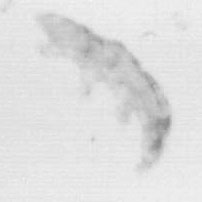Today, I opened the intro labs from 12-2 for prospective students, as I've done for the past 5 years. Lucy and Plato and I went up to Pelham (after taking him for his usual turn through town) to collect a few things for people to look at. There is a small depression in a hemlock grove near Amethyst Brook which collects water and has an extremely dense concentration of copepods, ostracods and other small pond-life organisms. Last year, the depression had been dry and I had been hard-pressed to find anything for people to look at, but this year things were fine. I also collect some bits of lichen and and a little water from a wetland in a sunnier location, hoping to find some algae (it's too dark under the hemlocks for any algae to show up).
The labs are always prepped for the Enzyme Lab during the week of the open house event, but I set up several different stations around the lab for people to look at things. I set up stations with compound scopes, dissecting scopes, a spectrophotometer, and some with computers pointed at the  learning goals,
learning goals,  the Gallery of Biological Imagery (to learn about local faculty and research),
the Gallery of Biological Imagery (to learn about local faculty and research),  Protein Explorer, and a couple of
Protein Explorer, and a couple of  netlogo simulations. The turn out was a tad smaller this year (which was surprising because I had heard that a larger number of prospective students were visiting), but the people seemed particularly interested and asked a lot of good and thoughtful questions.
netlogo simulations. The turn out was a tad smaller this year (which was surprising because I had heard that a larger number of prospective students were visiting), but the people seemed particularly interested and asked a lot of good and thoughtful questions.
For the past three years, I've floated some of the lichens in water and looked for tardigrades at the bottom of the dish -- last year I didn't get any to emerge in time to find them for the open house, but this year it went fine. Add a little water -- and the water bears come out to play.

From the picture, its really hard to visualize what water bears look like -- it's much easier with this  short video. I've always thought tardigrades were cool. But I've always been interested in unusual organisms. If I had been a biologist a generation or two earlier, I probably could have happily spent my entire career in a dark basement in an old building studing crinoids or tardigrades or conchostrachans.
short video. I've always thought tardigrades were cool. But I've always been interested in unusual organisms. If I had been a biologist a generation or two earlier, I probably could have happily spent my entire career in a dark basement in an old building studing crinoids or tardigrades or conchostrachans.